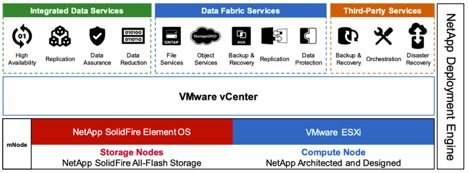Overview of the NetApp HCI Infrastructure Platform
 Suggest changes
Suggest changes


NetApp HCI provides great flexibility combined with enterprise level capabilities. Let's delve into the features and benefits of the platform.
Overview
NetApp HCI is an enterprise-scale infrastructure that consists of a mix of storage nodes and compute nodes. NetApp HCI delivers predictable performance on a highly flexible, efficient architecture, making it easy to manage. With NetApp Element software, you unlock the power of the data fabric, enabling NetApp HCI to participate in hybrid cloud services.
The installation and configuration required to deploy VMs are automated with NDE. Compute clusters are managed with VMware vCenter, and storage clusters are managed with the vCenter plug-in that is deployed with NDE. A management VM called mNode that deploys as part of NDE handles version upgrades, pushing events to vCenter, vCenter plug-in management, the VPN tunnel for support, and the NetApp Active IQ® collector. It also enables you to extend NetApp cloud services to on-premises environments, thus enabling hybrid cloud infrastructure. With multiple options for compute and storage nodes,
NetApp HCI is suitable for multiple workloads, including:
-
DevOps
-
Container workloads
-
Edge computing
-
Database workloads
-
Artificial intelligence
-
Machine learning
-
Virtual desktop infrastructure (VDI)
NetApp HCI Use Cases
-
On-premises private clouds. With the option to start small and grow your infrastructure, NetApp HCI future-proofs your datacenter for later growth and flexibility.
-
Hybrid clouds. NetAppHCI can serve as the infrastructure for hybrid multi cloud or private cloud deployments.
-
End-user computing. You can deliver anoptimal user experience with NetApp HCI and VMware Horizon.
-
Workload consolidation. NetApp HCI QoS settings let you deliver guaranteed application performance.
NetApp HCI Key Features
NetApp HCI provides enterprise reliability and availability. Some of the important features of NetApp HCI include:
-
Guaranteed performance
-
Allocate storage performance independent of capacity
-
Manage performance in real time without affecting other volumes
-
Guarantee performance to every volume with fine-grain QoS settings
-
-
Global efficiency
-
Inline and post-compression
-
Automatic distribution of data (no hot spots) with always-on deduplication
-
Global thin provisioning
-
-
Data assurance
-
NetApp HCI Helix RAID-less data protection
-
Real-time replication (synchronous and asynchronous)
-
Integrated backup and recovery (cloud)
-
Data and performance availability regardless of system condition or application activity
-
Data safeguarded with 256-bit encryption
-

NetApp HCI Design Principles: Predictability, Flexibility, Simplicity
NetApp HCI gives you flexible and straight forward control over your enterprise-class workloads. It is designed to provide predictable performance, linear scalability, and a simple deployment and management experience.
-
Predictable
-
Prevent noisy neighbors and satisfy performance SLAs with industry-leading performance QoS.
-
Combine Storage Policy Based Management (SPBM) toautomate and manage QoS.
-
-
Flexible
-
Confidently scale compute and storage nodes independently with zero share architecture.
-
Prevent inefficient over provisioning and reduce TCO.
-
Mix small, medium, and large compute and storage configurations.
-
-
Simple
-
With NDE, eliminate manual deployment and risk of user errors.
-
Manage NetApp HCI with the Element Plug-in for vCenter
-
Compute and Storage Nodes
NetApp HCI offers multiple form factors for various compute and storage needs. A minimum starting configuration includes two chassis with two compute and four storage nodes. More nodes are needed for GPU-driven workloads such as VMware Horizon or machine learning. Compute nodes used for database workloads are also available with this architecture.
Compute Nodes
NetApp H300E, H500E, and H700E nodes are based on Intel Xeon E5 v4(Broadwell) processors. NetApp HCI H410C and H610C nodes are based on Intel Scalable (Skylake) processors. The NetApp HCI H610C node contains two NVIDIA Tesla M10 cards. NetAppHCI compute nodes can scale up to 64 per cluster.
NetApp strongly recommends reading the NetApp HCI datasheet for more information about NetApp HCI compute and storage offerings. For details about how NetApp HCI works, see the NetApp HCI Theory of Operations white paper.
Storage Nodes
Storage nodes are available on either half-width or full-width rack units. Half-width rack units are populating two rack unit chassis, which can contain either storage or compute nodes. At least four storage nodes are required and can be expanded to up to 40 nodes. A storage cluster can be shared across multiple compute clusters offering asynchronous, synchronous, and Snapshot replication methods for integrated data service. Storage nodes contain a cache controller to improve the write performance. A single node provides either 50K or 100K IOPS at 4K block size.
NetApp HCI storage nodes run Element software, which provides a QoS feature that supports minimum, maximum, and burst limits. The storage cluster allows a mix of storage nodes; the only caveat is that one storage node size can’t exceed 1/3 of total capacity.
Element Software
Element software is designed for data centers that require rapid, modular growth or contraction for diverse workloads. Because of its flexible handling of permanent and transient workloads with varioust hroughput and capacity requirements, Element software is the storage infrastructure of choice for service providers.
Element provides modular, scalable performance with each storage node, delivering guaranteed capacity and throughput to the environment. Each Element storage node added to aNetApp HCI environment provides a set amount of IOPS and capacity, allowing predictable, planned growth.
Because each node provides a set throughput (IOPS) to the storage environment, QoS for each workload can be guaranteed. Element helps you ensure minimum SLAs because the total throughput of the cluster is a known, quantifiable amount. For more information, see the Element software product page.
Element software is 100% programmable and delivers unmatched agility and guaranteed application performance. With the ability to mix nodes within a cluster, you can build a private cloud architecture to meet your business needs at any scale.


